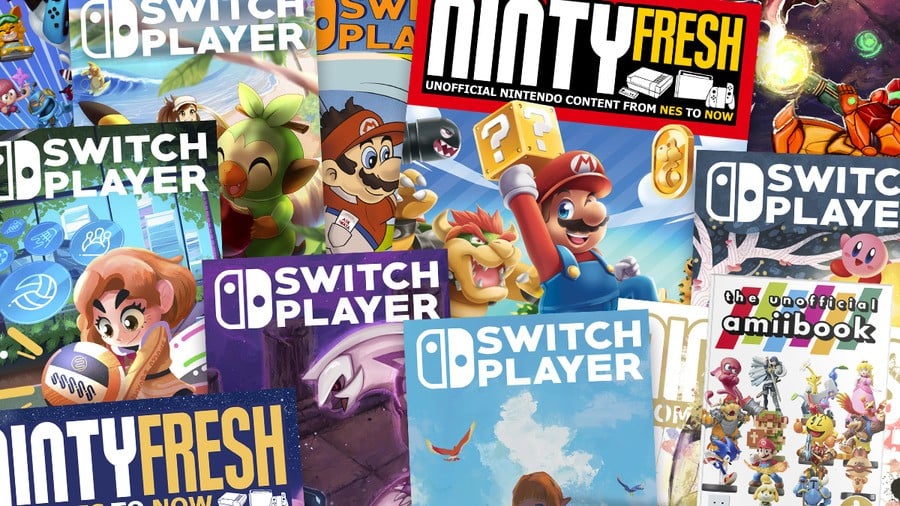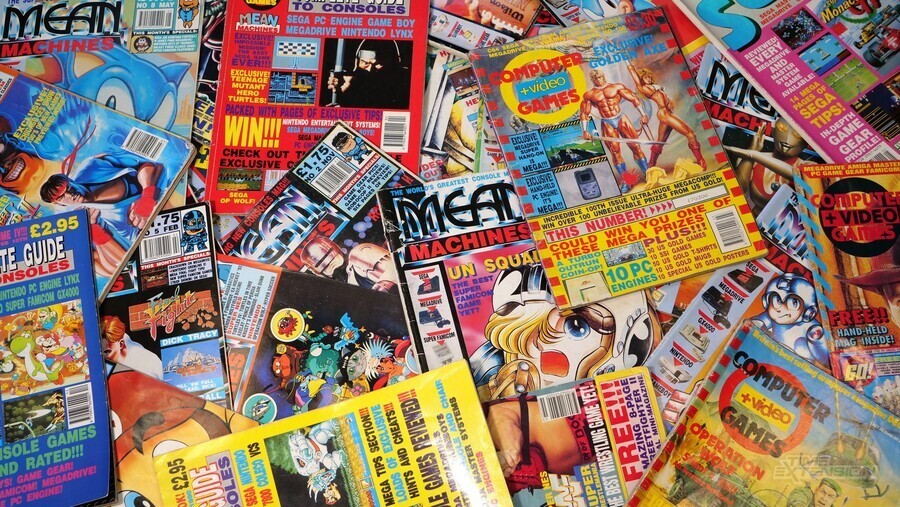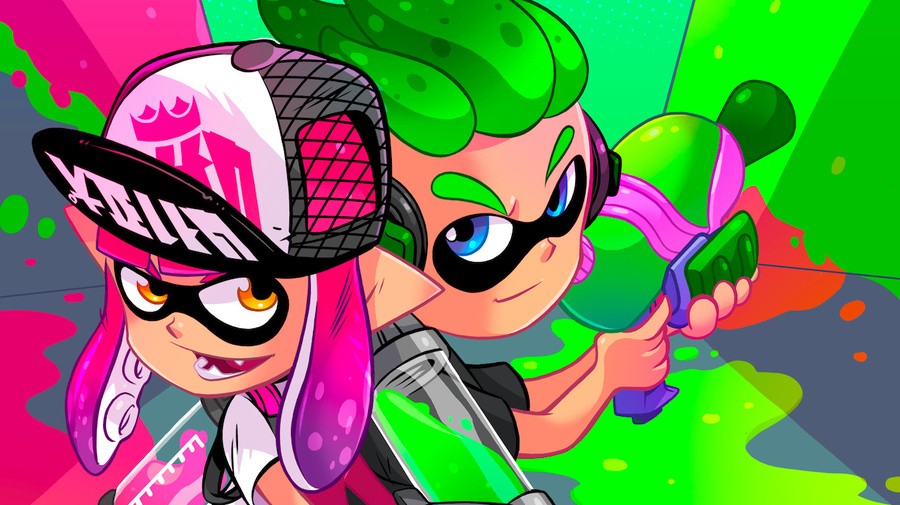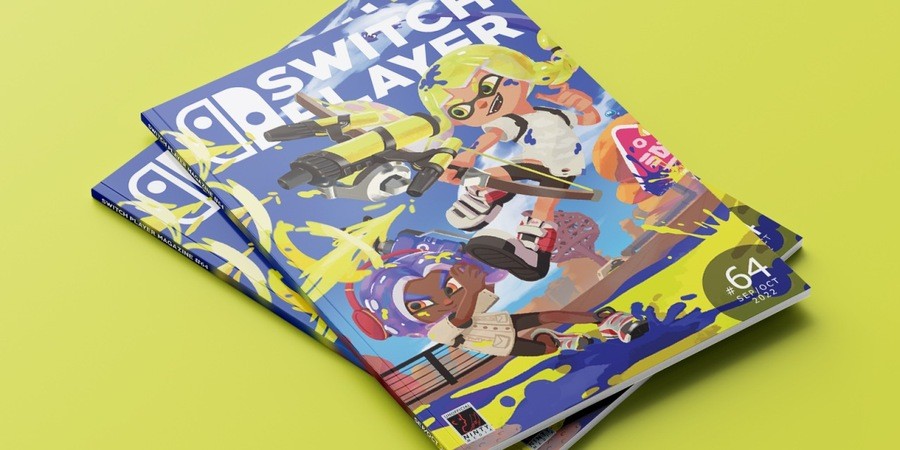
For as long as I can remember, I always wanted to make magazines. Even in secondary school, when tasked with a project on the (then under construction) Channel Tunnel, I made a 40-page 'magazine' about it. You could say I’m obsessed. (My wife certainly thinks so.)
Before the internet emerged, we all got our gaming news from magazines. I spent a large chunk of my pocket money on journalistic institutions like Mean Machines, TOTAL!, Super Play, and of course, Nintendo Official Magazine (and the subsequent Future-owned version, Official Nintendo Magazine). Special mentions also to Games Master and Games World. (No, not really, Games World was a bit pants.)
Looking back now, I probably spent more money on magazines than I did on games, which is probably why I’m so terrible at the latter, yet have a fond affinity for print products. Anyway, these publications were full of news, reviews, puns, low-level smut, innuendo, and all other sorts of silliness. But they left their mark on me. At least, until they started to fall away, one by one.
Once upon a time, you would go into your local newsagent and gaze upon shelves packed with a smorgasbord of choice for your pleasure. (No, not that shelf, the one under it, usually.) These days there’s very little to choose from, especially for Nintendo. You’ll find some games covered in the pages of the eternally amazing EDGE, or even in the wonderful Wireframe. That’s about it. No official Nintendo magazines. No more GamesTM. No more Games Master. These have all fallen away as the corporate juggernauts slash choice and jobs across the joint.

Today, you probably source your information through the online medium, via brilliant outlets like the one you're reading right now. But websites, however well designed, cannot hold a candle to the glory of the print medium in this author’s opinion. The flow of words, interspaced with glorious artwork and massive screenshots. Presented in a way that flowed beautifully and caught the imagination. The sheer glory of a multitude of information, all compacted in a single publication that you could read at your leisure.
My fascination with magazines never abated, however, and we had a conversation. Could the entire website operation be converted into a magazine?
I would read in awe about new systems being released half the world away, admire swanky new releases that I could only dream of playing, and see my own opinions affirmed by people whose writing I adored. These writers were my heroes and inspiration, and if I could meet younger me, I’d tell him to follow his dreams. The lesson here, I suppose, is that it’s never too late. And that’s what I set out to do.
After re-evaluating my life choices around 2012, I started writing about games for my own website (as I would recommend anyone serious about getting into games should do), but the thinking was always about how we turn this project into a magazine. That website was called The Vita Lounge, created due to a lack of coverage in the mainstream media. My team and I very quickly realised that there weren’t that many places covering the little device and our humble site would go on to get around five million visits a year. Not bad for a little fan venture, I’m sure you’ll agree.
My fascination with magazines never abated, however, and we had a conversation. Could the entire website operation be converted into a magazine? We certainly thought so, and that’s what we set out to do in 2014. The Vita Lounge Magazine, later Vitamag, was born. (Vitamag was a way better name; I really wish I’d thought of it in the beginning.)

The advent and success of crowd-funding operations opens ways for those of us with ideas to see them through to fruition, and although we had a very small reach (some 100 supporters) we were able to make 26 issues of a little A5 magazine dedicated to Sony’s unappreciated handheld. We absolutely loved making that fanzine because the Vita is truly a phenomenal machine. But it wasn’t my first gaming love – that always belonged to Nintendo.
The decision to be small and slight was deliberate; by using this framework, the magazine weighed less than 100 grams. Which, for the uninitiated, is the limit for a UK first-class stamp, meaning they qualified as a letter
Where this journey really began to gain traction was in October 2016, with the worldwide reveal of the Nintendo Switch. We all watched in amazement as the gameplay “switched” as the matey took his dog for a walk and he continued to play Breath of the Wild on the go. Whilst that bloke sat down in the airport and rinsed through Skyrim on the plane. And whilst “Karen” ignored her mates having a roof party to play Super Mario Odyssey. And then took the system over to said party. My team and I immediately knew that everything we were doing at Vitamag could be replicated for this new Nintendo device, and thus Switch Player Magazine was born.
We launched our first issue in February 2016, prior to the system’s launch. The magazine was A5 in size, and like Vitamag, used Patreon to crowdfund upfront and was 48 pages in size. I was lucky enough to be invited to the press event in January and was able to get hands-on with so many upcoming games, which all went into that debut issue. Its sizing and pricing model was set for many reasons: our limited success with Vitamag, the sales of the Vita and the sales of the Wii U. With comparative numbers, we didn’t expect the Switch to sell that well. The decision to be small and slight was deliberate; by using this framework, the magazine weighed less than 100 grams. Which, for the uninitiated, is the limit for a UK first-class stamp, meaning they qualified as a letter.
We wanted to make something affordable yet informative, creative yet realistic. For a system we didn’t anticipate would perform particularly well, given Nintendo’s performance at the time. What a bunch of wallies we look now! Before the end of the next fiscal year, the Nintendo Switch will likely have become the third-best-selling device of all time. Hindsight is a wonderful thing…

We themed each issue by having the main review title as the cover game, and one of our core ethoses was (and is still) having bespoke cover artwork. From our second issue, we began working with artists to give our magazines a unique and artistic design with the hope that our covers would stand out. As we continued to grow our audience, we began taking on feedback and, over time, the reviews/features balance has been addressed, and we continue to this day to follow direction based on our audience's preferences. After all, we make these things for the readers, and we would be nothing without their belief and support. We had an idea, but the audience really bought into it.
Along the way we’ve had many team members contribute; one of my proudest feelings about the whole venture is watching people find their start with us and then discover bigger opportunities within the industry.
Along the way we’ve had many team members contribute; one of my proudest feelings about the whole venture is watching people find their start with us and then discover bigger opportunities within the industry. There are people on this very group of websites that wrote more than a few words for Switch Player, as well as many freelancers whose work you may have seen. I had always hoped it could be a vessel to allow others to achieve great things, and we continue to work with freelancers today.
Over the last six years, we have released 64 issues of Switch Player, and at the time of writing, we launch a new issue every two months. We were monthly, but in recent times our audience is reducing. At the height of its reach (coinciding with lockdowns in the UK), we had nearly 900 supporters backing a copy each month. Today that number is closer to 500. That high point was also aided by Reggie Fils-Aimé retweeting one of our issues. You can see our Top 40 Games special on display behind him in videos!
As you can imagine, we hadn’t originally anticipated having close to 1000 supporters at Switch Player. Having a magazine dedicated to the Nintendo Switch was awesome, but it came with limitations. Budget for one, but also scope. We felt that there was space in the market for something that focussed on the nostalgia which probably addicts us all to this Japanese company. And this is how Ninty Fresh was born.

It started as an additional project for my sanity in the first lockdown, and we wanted Ninty Fresh to be everything that Switch Player wasn’t. We wanted to focus on retro, but also have a smattering of Switch content. So it was important for us to have that retro focus that everyone loves from Retro Gamer, but with a Nintendo flavour. But we still wanted to have relevance in today’s gaming scene. A retro/fresh hybrid if you will. As Ninty is a term of endearment used by fans (at least in those magazines from my youth) that’s where the name came from.
It’s important and has always been important that people don’t do this for “free” or for “exposure”. You cannot spend exposure; if you can, I’m not sure which establishments accept it
The first Ninty Fresh was a resounding success. With almost 1500 supporters via Kickstarter and additional purchases, issue 1 launched in June 2020 and was themed around 35 years of Super Mario. Our cover was a play on the first and last issues of Nintendo Power, and we spent well over 20 pages talking about mainline Super Mario games. Well, the ones Nintendo consider mainline anyway. We managed to get some commentary from many folks within the industry, former magazine editors — even Hookshot Media’s Damien McFerran said a few words.
With 100 pages in total, retrospectives on games, systems, and much more, Ninty Fresh was very much the magazine we’d hoped to make all along. A bigger budget and reach meant that the team could be paid more. Everyone that works on these projects is doing it in their free time, around real jobs and lives, but everyone does receive compensation for that time. It’s important and has always been important that people don’t do this for “free” or for “exposure”. You cannot spend exposure; if you can, I’m not sure which establishments accept it. I’m having a hard time finding places that want to take physical coins these days.
Each issue so far has represented a core Nintendo franchise. Super Mario. F-Zero. Pokémon. The Legend of Zelda. Metroid. Donkey Kong. And Kirby. How many of these games did you play? And love? Feeling warm and happy? That’s what we wanted to capture and emblazon on bits of dead trees, just like the old days. As we went through, we started supplanting the text with some unique artwork too, to really accentuate that nostalgia, more than screens could. The issues aren’t just about that franchise, though, and I suspect this is where the magazine’s troubles began. Folks that have no interest in a specific franchise wouldn’t support that issue. What we felt would be a massive draw started to become a bit of a turn-off. Which leads us to where we are now. Making something that fills a hole — something that there is demand for but is struggling to find reach.

My time writing for the magazines has been incredible and opened so many doors and opportunities. I’ve been able to get to Gamescom and meet so many people in the games industry. I’ve interviewed Suda 51 (twice!) and Junichi Masuda. I’ve been to game launches and events, and even had first-party access to Nintendo games at their UK offices. It also opened the opportunity for me to write a book. Albeit crowd-funded and managed by me, but a book, nonetheless.
I wasn’t prepared for that level of interest. I also wasn’t prepared for that level of scrutiny from Nintendo’s legal team, and the campaign was abruptly halted with a trademark takedown.
My mantra has always been to either do something better than someone else or do something different. That’s how you stand out in, quite frankly, a highly competitive and challenging medium. Having purchased all 200+ amiibo figures, I was quite surprised to see that there wasn’t a book about them, so I set about changing that. Well, to be honest, I was trying to think how I could make a magazine special about it. I’m quite glad I changed my mind.
I resigned from working in a school (as a teaching assistant) and thought that I’d give the whole venture a go full-time. The campaign for what I originally called The Unofficial amiibo Handbook was a resounding and unprecedented success, with some 1500 people buying into my idea. I wasn’t prepared for that level of interest. I also wasn’t prepared for that level of scrutiny from Nintendo’s legal team, and the campaign was abruptly halted with a trademark takedown.
Now, many people think that if you make a crowd-funded project around someone else’s IP, you’ll instantly be hit with a copyright strike. This isn’t quite the case; the law around “fair use” of copyrighted material is quite complex and there’s a grey area for sure. I wasn’t issued a cease and desist; I was told I couldn’t use copyrighted logos. Most Nintendo game names are trademarks, you see, and by using official logos in unofficial material, you are directly infringing that. Additionally, the word “amiibo” is a trademark, and by using it as a name – in the same Bauhaus 93 font – it could give the impression that the project is licensed or endorsed. Despite the word “unofficial”.
So, I removed the logos, simplified the design somewhat and called it “The Unofficial amiibook” instead. Crisis averted, and a few emails (and 40,000 words) later the book was finished and released. As with all projects, I recognise that there are things I could have done better, and perhaps more comprehensively. Luckily, they are still releasing amiibo, so perhaps I’ll get to have another go in more detail!
Unfortunately, despite many years of passion and love poured into these projects by some amazing people over the years, we now find ourselves at risk too... We have no corporate backing, no stacks of advertising revenue
Back to the magazines though. I know that I am lucky that so many people buy into the vision I had many years ago. For me, there was a massive void where those publications used to be, and although habits and tastes change, the amazing number of people that supported us only validated that what we did was needed. Nintendo Power closed in 2012 in the United States, with Nintendo Gamer doing the same over on my side of the Atlantic in the same year. Nintendo would go on to shut down ONM in 2014 and other official magazines followed suit around other markets. Sad times indeed. Today, we aren’t the only Nintendo venture in the world, with many attempting the same crowd-funded initiative overseas, and a mainstream publication is still available in Germany, called N-Zone.
Unfortunately, despite many years of passion and love poured into these projects by some amazing people over the years, we now find ourselves at risk too. We are just an enthusiast venture. We have no corporate backing, no stacks of advertising revenue. We make something based on a medium we love for a medium we love, and our reach is limited. We know that times are hard, and totally understand that not everyone has the time or finances to justify supporting something like us. And we are OK for now; our projects are set to be cost-effective. But at our current levels of supporter loss, we will be unsustainable.
People might look at the numbers that the Kickstarter campaigns make and wonder what I am on about, but they probably don’t realise that Kickstarter takes close to 10% with processing fees. Then we must pay for the magazines ourselves, of course, and that’s around 25%, and the postage is close to 40%. That remaining quarter is distributed to the writers, artists, and the designer.

We have a contingency plan and know that ultimately two magazines may have to become one. We don’t want to go the way of so many other magazines, and we want to continue to provide an alternative source of Nintendo Insight for a multitude of fans and grow our team, so we represent all voices and backgrounds, give opportunities to writers and artists and continue to make something incredibly special. Because we want to celebrate games as art. We want to inspire the next generation of writers. And we want to show people that you can realise your dreams.
I learned a long time ago you can’t make something for everyone and that there will always be people that will be disappointed. But you can at least try to create something that works for the most, and that’s what we'll keep trying to do
To do that, we need the support of like-minded folks. We need to know what you would want to see in a magazine. I learned a long time ago you can’t make something for everyone and that there will always be people that will be disappointed. But you can at least try to create something that works for the most, and that’s what we'll keep trying to do. And so I ask — will you join us as we try to rekindle the imagination and make something special?
For me, magazines are essentially like a time capsule. They perfectly capture a specific period, and despite the obvious benefits of the internet, it lacks that same feeling. That well-rounded and superbly presented charming product. The variety of features and content without having to click. Something that you can read at your leisure, not in dribs and drabs around an otherwise hectic schedule. Something you enjoy over a few weeks until the next one. For many of you, I know you’ll be remembering what that was like. If so, then I’m certain you’ll love us and what we do.
Now, I appreciate that there’s a huge amount of irony in using the internet to convey all these thoughts, but you’ve read it all now, so what are you going to do? All that’s left to say is that if you love what someone does, whether that’s a website, fan site or anyone in the creative field, please support them however you can. That support might just keep them going.






Comments 10
Go on, release a brand new special edition issue of Mean Machines--it's still one of the greatest video game magazines of all time imo--that would be beyond awesome. I would snap that up in a heartbeat.
I used to subscribe to Switch Player and it was fine and nice to get something in the mail each month (and then eveyr other month) but it didn't really have anything unique to justify it. The reviews, not to disrespect those that wrote them, were just the kind you can read on any website, like NintendoLife, and the features were also the "Here's the history of ____" you get online as well. I don't know what the answer is to make it feel unique, but it just didn't for me.
Great article. I appreciate your appreciation of the industry and art.
Brings back the memories of the doomed Australian ‘Nintendo Gamer’ which lasted about 4 issues in 2009. But 12 year old me still checked out the newsagent periodically for a few years just in case. At least we did get N-Gamer as well after the fact. (Though with all these names you’d believe they were all the same)
Perhaps it’s a nostalgia thing that just can’t compete with how things are now, similar to the old joys of tight-knit forum communities. I might just give Ninth Fresh a go though and see if it can scratch the itch.
I subbed to Switch Player for a few years but lost interest when the multiple changeovers in staff made it seem like the mag was constantly in a holding pattern. Once you started the second mag it felt like very little effort was going into Switch Player.
I picked up a few issues of Ninty Fresh and it was really enjoyable but with no option to subscribe its easy to forget about.
I love gaming magazines. The problem for me is that living in the US means either these are either not available or the shipping cost is just too much. But in the US I subscribe to Nintendo Force and Game Informer. I look forward to getting each of them.
Got one NintyFresh issue, but a promise made in the kickstarter wasn’t followed through with, along with poor communication. Unfortunately there seemed to be a lack of dedication to the effort as a whole.
What @boatie mentioned above is absolutely on point as well.
I recommend supporting Phil Summers’ work instead: https://www.patreon.com/handdrawngaming/posts
Amazing how much the first few paragraphs relate to my upbringing too. I subscribed to and purchased a bunch of magazines during the '90s- less so during the 2000's. And when I wasn't reading them, I was making my own. Sadly, I no longer have them- I would love to read through them again and see how hack they probably were through adult eyes.
I missed this one when it first came out. Just wanted to say great article and a fascinating insight into indie magazine publishing.
Show Comments
Leave A Comment
Hold on there, you need to login to post a comment...